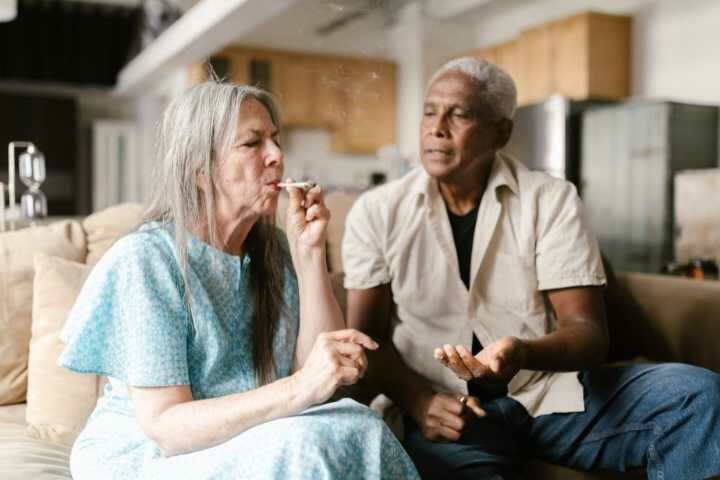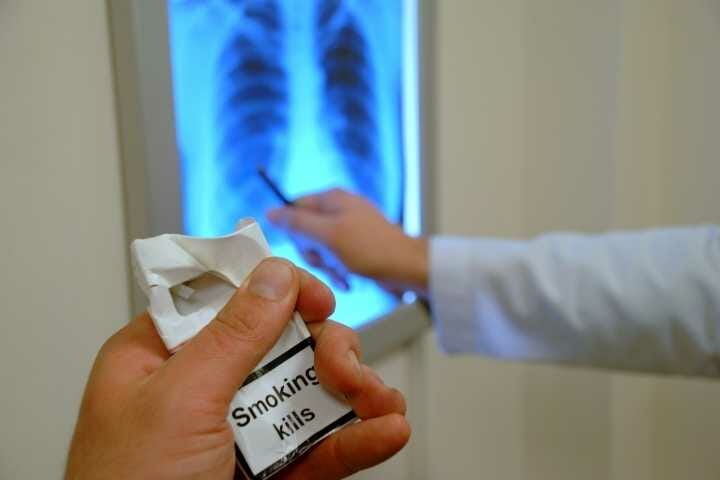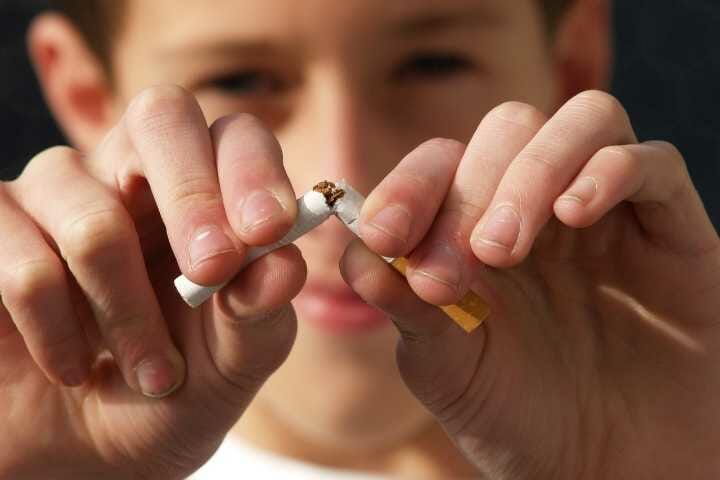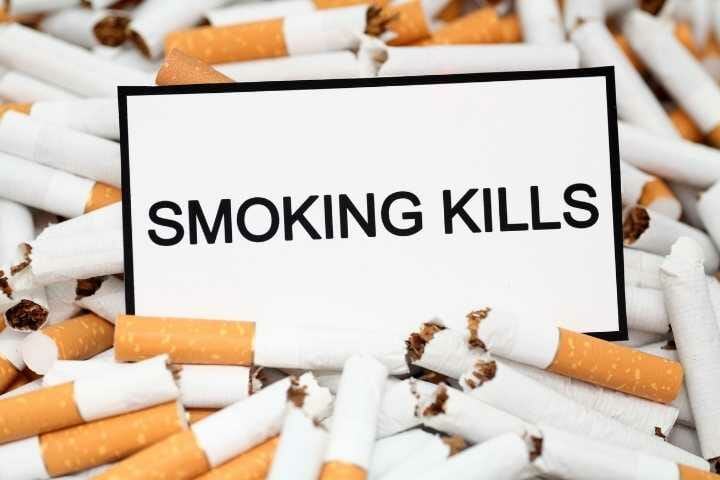This is a caregiver’s guide to working with seniors who smoke. We discuss the problem, its impact on those who work near smokers, and what you need to do to deal with it.
Contents
Working as a gerontological nurse is both gratifying and exhausting. Nursing home residents frequently require 24-hour care, and those who look after them must keep them company and ensure that their medical and other requirements are satisfied.
Nursing home residents are more likely to be in poor health than other adults and older adults. Thus the danger of being exposed to cigarette smoke is considerably more severe for them. This adds to the responsibilities of anybody working as a caregiver in a nursing home: safeguarding residents from secondhand smoke.

Smoking Facts And Statistics
The Extent Of The Problem
- In 2019, over 14 out of every 100 adults in the United States aged 18 and above smoked cigarettes (that’s nearly 34.1 mn adult smokers).
- Smoking-related ailments affect more than 16 million Americans.
- Cigarette smoking is still the most significant cause of avoidable disease, disability, and death in the United States, accounting for about 480,000 fatalities each year, or around one in every five deaths.
How Big Is The Problem In The Elderly?
- While only 8.4% of elderly people smoke (as compared to 22% of the young), they are only half as likely to quit smoking.
- Elderly people are more likely to smoke if they are male, African-American or Native American, non-college graduates and earning less than $25,000
The Good News
Smoking prevalence has decreased from 20.9 percent (almost 21 of every 100 individuals) in 2005 to 14.0 percent (14 of every 100 adults) in 2019, with the number of former smokers quitting increasing.
Even if you quit at the age of 60 and above, there are significant health-related benefits that you can reap from it.

Consequences Of Smoking
If you aren’t mortified with the statistics mentioned above, let’s further frighten you with some of the consequences of smoking on the human body:
- Regular smokers lose more than ten years of their lives.
- Research has linked smoking to a litany of diseases such as:
- Bronchitis/Lung disease.
- Emphysema
- Heart disease
- Cancer.
- Flu & pneumonia (any infection related to lungs and breathing).
- Osteoporosis
- AMD, loss of vision, Eye diseases
- Type 2 Diabetes. Diabetes is further linked to a whole host of other problems.
Specific Consequences in Older Adults
- Smoking has been linked with the occurrence of Alzheimer’s and dementia in older adults in many studies.
- Smoking causes cause dry skin and wrinkles.
- Muscular atrophy, lower oxygen levels (extremely harmful especially considering the Covid-19 pandemic)
- Loss of sense of taste and smell
- Blackening of teeth and oral cancer
- Erectile dysfunction in advanced age has often been linked with smoking.
Social consequences of smoking
- Smoking is often looked down upon by non-smokers as an irritant as the best and downright deal-breaker for others.
- The pungent odor of smoke is unbearable for many people, and some are even allergic to the smoke produced.
- It might sound cliche, but above a certain age, you are an example for younger people and kids. You might want to think about what kind of message you are sending out for your grandkids when they see you smoke.

Second-Hand Smoke: Impact On The Elderly
Indirect smoking can cause many health issues, but it typically has the same effects as active smoking. People who are exposed to indirect smoking, for example, are more likely to acquire lung cancer or have cardiac difficulties. It also has an impact on lung function and can lead to asthma in adults.
Secondhand smoking poses a significant threat to everyone, but especially the elderly. It’s incredibly harmful to add the risk of indirect Tobacco to the mix because older individuals are more likely to have cardiac issues, and many have lung problems.
Furthermore, because many elderly persons have a history of smoking or indirect smoking exposure, continuing exposure in old age is highly harmful.
Second-Hand Smoke: Impact On The Caregiver
If you are a caregiver to a smoker, secondhand smoke impacts you as well. After all, nearly 7,300 people die each year due to lung cancer contracted from secondhand smoke.
Therefore, as a caregiver, it is doubly important for you to:
- Protect yourself
- Insist that the older adults that you are caring for at least attempt to quit
Given this background, you should read the various pointers in our section below about how tobacco use can be prevented.
While assisting older smokers in quitting is more difficult because they might have a lower desire to quit, it is also true that if they attempt to leave, they have a better chance of succeeding. As a result, encouraging people to attempt quitting should be a key focus for caregivers.
Women And Tobacco Use
Tobacco use and smoking represent a significant risk of early mortality and disease in women. Each year, an estimated 202,000 women in the United States die as a result of smoking. 1
In 2016, 13.5 percent of females in the United States smoked, compared to 17.5 percent of males.
Men and women now have a much narrower gender difference than they had in the past, and women carry a significantly higher cost of smoking-related diseases and fatalities.
Elderly women are more likely to continue smoking than men.
Studies show that 25.6% of women entering the 50’s and 60’s continue to be current smokers, as compared to only 18% of male smokers.

Women in some ethnic groups are more likely to smoke than women in other ethnic groups.
For example, Native American / Indigenous women in Alaska smoked 34.8 percent of the time in 2016, compared to 15.5 percent for non-Hispanic white women, 7.0 percent for Hispanic women, and 7.0 percent for Asian-American women.
Smoking rates are significantly higher in lesbian and bisexual women than in heterosexual women.
In 2016, smoking prevalence among women identified as bisexual or lesbian was 17.9%, while smoking prevalence among women identified as heterosexual was 13.5%
This difference can be the result of several factors, including social stigma, sexual orientation, and gender discrimination. Identity targeted marketing. In the United States, smoking is directly involved in 80% of women’s lung cancer deaths each year.
Tobacco marketing has disproportionately targeted women.
Topics associated with social desirability, independence, weight control, and amusement dominate these advertisements. They frequently show slender, beautiful, and athletic models, as do most other promotions.
Some adolescent females begin smoking to prevent gaining weight, while others find it self-sufficient and appealing.
Health Facts Regarding Smoking In Women
In 2014, an estimated 70,700 women died of lung cancer and bronchial cancer. In 1987, lung cancer outnumbered breast cancer as the leading cause of cancer deaths in women in the United States.
The risk of lung cancer in women increased tenfold from 1959 to 2010. Women who smoke are 22 times more likely than women who have never smoked to die of chronic obstructive pulmonary disease (COPD), including emphysema and chronic bronchitis.
Women who smoke are more likely to acquire COPD at a younger age. Women who smoke have a higher risk of mouth cancer, throat cancer, laryngeal cancer, esophageal cancer, pancreatic cancer, kidney cancer, bladder cancer, and cervix cancer.
It also increases the risk of coronary artery disease by a factor of two. Females who smoke after menopause have decreased bone density than women who have never smoked.
When compared to non-smokers, women who smoke have a higher risk of hip fractures. Smoking can create wrinkles in the skin and accelerate aging in smokers.

Preventing Tobacco Use Among Youth
Smoking does not only impact the older adults who are smokers; it also impacts the children and grandchildren of those people. Let’s talk about how harmful secondhand smoke can be to your children.
Some Facts About Second-Hand Smoking In Children
- Children are exposed to secondhand smoke at a higher rate than nonsmoking adults.
- Children aged 3 to 11 have levels of cotinine that are more than double those of non-smoking adults.
- Children who live in nonsmoking multi-family residences (apartments, condominiums) have cotinine levels that are around 45 percent higher than those in nonsmoking single-family houses.
- Parents are responsible for an astonishing 90% of children’s exposure to secondhand smoking.
- More than half of American children are exposed to secondhand smoke in automobiles, homes, and public locations where smoking is permitted.
What Is Second Hand Smoke?
Secondhand smoke, also known as ETS (environmental tobacco smoke), is a mixture of exhaled tobacco smoke (mainstream smoke) and burning tobacco smoke (sidestream smoke). It’s a terrible mixture of over 7,000 compounds, 250 toxic compounds, and over 70 of them carcinogens.
Children and Secondhand Smoke
Young children are especially vulnerable to secondhand smoking. Secondhand smoke causes 150,000 to 300,000 lower respiratory tract infections in newborns and children under the age of 18 months per year, resulting in 7,500 to 15,000 hospitalizations. It also causes 430 fatalities in the United States each year due to sudden infant death syndrome (SIDS).

Secondhand smoke exposure can lead to a buildup of fluid in the middle ear, resulting in 790,000 medical visits per year and more than 202,000 asthma flare-ups in youngsters. In the United States, more than 23 million youngsters, or nearly 35%, have been exposed to secondhand smoke.
Why Does Second Hand Smoke Impact Children More?
Children are more susceptible to the harmful effects of indirect smoking than adults. Children’s breathing rate is faster than adults’ breathing rate, so when the air is contaminated with tobacco smoke, the developing young lungs receive higher levels of inhaled toxins than the old lungs.
Adults breathe an average of 14-18 times per minute, while newborns can breathe up to 60 times per minute. 2 Boys have a relatively high respiratory rate until they are about five years old. The children had little impact on the environment when they were young.
Babies and toddlers cannot move to another room because there is smoke in the air. They rely on adults in their lives to ensure that the people around them are safe.
Scientists have discovered many risks associated with indirect smoking in young children. Research is still underway, but there are some horrifying data on how this dangerous air is damaging the health of our children are below:
Effects on the Fetus
Smoking affects newborns during pregnancy in several ways, including:
- Babies born to smoking mothers often weigh less at birth than babies born to non-smoking mothers. Low birth weight is one of the most common causes of neonatal death.
- Babies born to mothers who smoke during pregnancy are more likely to have developmental problems such as cognitive impairment and cerebral palsy.

Effects on children’s health
Some of the effects of indirect smoking on children are listed below.
Newborns exposed to indirect smoking are twice as likely to develop sudden infant death syndrome (SIDS) after birth as newborns who are not. SIDS can occur 3-4 times more often in babies who smoke before and after their mother is born.
Indirect smoking is associated with 150,000-300,000 cases of lower respiratory tract infections such as bronchitis and pneumonia in children under 18 months each year in the United States.
According to the EPA, indirect smoking is thought to exacerbate the condition of 200,000 to 1,000,000 asthmatic children. Secondhand smoke is believed to cause thousands of new cases of asthma each year.
Children living in smoking families are more likely to develop otitis media. Inhaled cigarette smoke irritates the Eustachian tubes, causing swelling and infections that are the leading causes of hearing loss in children. Frequent indirect smoking slows the growth of the lungs in children. Studies show that indirect smoking is linked to juvenile leukemia, lymphoma, and brain tumors.
Ever Heard of Third-Hand Smoking?
As more research is done, more hazards related to smoking are uncovered—for example, third-hand smoke. Toxic particulate matter in cigarette smoke and residue from gasses settles on many surfaces and remains in place.
This is not healthy for anyone, but it is especially problematic for infants who open their mouths after crawling around their hands and knees and playing with toys.
The only way to protect your baby is to quit smoking altogether. However, it is also essential to keep your child away from other smokers and avoid indirect smoking when visiting their place.
For example, if an older adult smokes, it is very unhealthy to take a baby to their room. I don’t think that opening windows and using air filters are enough to protect a child from third-hand smoke in closed rooms.
If your older adult smokes in your car, keep in mind that toxins settle down and are exposed to the surface, even if your child is not around. The next time your child sits in the car, he is exposed to the same toxins.

Tobacco-Free Living and Tobacco Control
Quitting smoking might be one of the most life-changing decisions you’ll ever make. Quitting smoking allows you to enjoy a longer, healthier life while also safeguarding the health of your family and friends.
Although quitting smoking might be challenging, there are several advantages to maintaining a tobacco-free lifestyle, including a lifetime benefit. Lung and other malignancies, heart disease, stroke, and chronic lung disease are only a few severe and frequently distressing disorders caused by smoking.
Even if you’ve been a smoker for a long time, stopping now can save your life and add years to your life. Also, don’t be discouraged if you’ve already tried and failed to quit smoking. Many people attempted to stop several times before finally succeeding.
Indirect smoking can cause cancer, heart disease, and other problems in non-smokers, putting your spouse, children, other family members, or friends in danger. In addition, children who are exposed to cigarette smoke are more likely to have SIDS, ADHD, asthma, and other respiratory disorders.
The most significant advantage of quitting smoking is that it prevents sickness and death, but there are several additional advantages.
- Your breath is cleaner, your teeth are whiter, and your hair and clothing smell nicer.
- Food tastes better, and the sense of smell returns to normal.
- Finger and nail discoloration is removed.
- Climbing stairs, completing domestic tasks, gardening, and keeping up with your children and grandkids are all possible.
- You can Visit restaurants, theaters, sports arenas, and other public areas where smoking is prohibited.
- You don’t have to be concerned about secondhand smoke affecting your family or acquaintances.
- You no longer have to waste time and energy trying to figure out when your next nicotine dose will arrive.
- Quitting smoking can also help you save money in the long run.
- You may save thousands of dollars not just on cigarettes but also on medical bills.
- You set an excellent example for your children and grandkids when you stop smoking. And if you don’t smoke, you won’t have to worry about developing lung cancer, heart disease, or other problems as you age.

Nicotine Dependence Centers
The Nicotine Dependence Centers’ treatment team supports you and collaborates with you to help you acquire the motivation and skills you’ll need to quit smoking.
Nicotine Dependence Centers provide the care that people who wish to quit smoking require, with professionals in smoking cessation guiding them as they attempt to live a tobacco- and nicotine-free life.
Counseling, medication, behavioral treatments, residential treatment programs, and relapse prevention measures are all available from the team of tobacco treatment professionals. Thousands of people benefit from stop-smoking services each year.
Clinics provide a range of smoking cessation services, including specialized assessment and planning, continuous in-person support through phone, online, or text, and an intense residential treatment program.
Care that is comprehensive and evidence-based
Doctors monitor nicotine addiction treatment programs. That implies the therapy procedure takes into account all facets of your disease. When required, your care team ensures that your nicotine addiction therapy is integrated with the care you are receiving for other medical concerns.
Follow the most recent clinical studies.
Nicotine dependency researchers have done clinical studies of medications that assist smokers in stopping smoking. They also look at behavior therapy, treatment results, nicotine addiction causes, treatment cost-effectiveness, and integrating optimal tobacco treatment methods into healthcare systems.
Provide Education Options For Smokers
Tobacco education for health care providers is available through the Nicotine Dependence Center Education Program. An annual Tobacco Dependence Treatment Conference, certification training for tobacco treatment specialists, patient intervention tools, distance learning possibilities, and tailored seminars are the services provided. Some educational programs may be available in your neighborhood.

Government Initiatives To Manage Smoking
The National and State Tobacco Control Program (NTCP) was formed in 1999 by the CDC’s Smoking and Health Office (OSH) to encourage coordinated national efforts to reduce tobacco-related diseases and death.
State and territorial health agencies get financing and technical help through this initiative. NTCP Support: Programs sponsored by the NTCP work to meet the OSH’s objectives.
Controlling and preventing the use of Tobacco and smoking have become essential parts of public health policies due to the medical effects of tobacco use, mainly passive exposure.
Tax rises on tobacco goods, for example, are used as a method of prevention at the political level. More rigid rules (and law enforcement agencies) govern who is allowed to purchase tobacco goods.
Smoking cessation policies in public places, bars, restaurants, and sticking/ printing health warnings on the packets are other ways that the government intervenes to prevent smoking.
Educate Yourself Further On Tobacco Use
Tobacco education for health care providers is available through the Nicotine Dependence Center Education Program.
An annual Tobacco Dependence Treatment Conference, certification training for tobacco treatment specialists, patient intervention tools, distance learning possibilities, and tailored seminars are the services provided. Some educational programs may be available in your neighborhood.
To help states and communities to conduct tobacco control programs, the Department of Smoking and Health (OSH) organizes national and local campaigns and events, collaborates with state and community resources, produces guidelines, and edits data.
